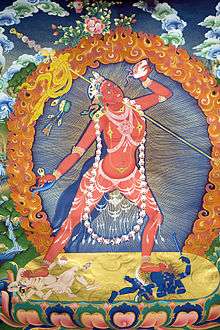Kartika (knife)
_symbol.svg.png)
| Part of a series on |
| Tibetan Buddhism |
|---|
 |
|
Practices and attainment |
|
History and overview |
|
A kartika (Skt. kartri, katari; Tib. gri-gug,[1] or kartrika in Nepal,[2] also sometimes referred to in Tibetan as a trigug or drigug) is a small, crescent-shaped hand-held ritual flaying knife used in the tantric ceremonies of Vajrayana Buddhism. The kartika is said to be "one of the quintessential attributes of the wrathful Tantric deities."[3] It is commonly known as the "knife of the dakinis."[4]
While the kartika is normally held in the right hand of a dakini in Vajrayana iconography and spiritual practice, occasionally it can be seen being held by esoteric male deities,[5] such as certain forms of Yamantaka.[6] It is also found frequently in the iconography of the Tibetan Buddhist spiritual practice of Chöd.
Iconography

In terms of iconography,
The dakini's knife has a flat sharpened blue iron blade with a curved hook at its outer extremity, which enables the flaying activities of cutting, scraping, and pulling. Its faceted or eight-sided handle is attached to the upper edge of the blade by either a leaf-shaped golden mount or the wide-open mouth of a golden makara, and the handle's top is sealed by a half-vajra.[7]
The same way that the bell and vajra are usually paired ritual items in Vajrayana spiritual practice and iconography (one is held in the right hand and the other simultaneously held in the left), the kartika usually appears as a pair with the kapala or "skull-cup".[8]
The shape of the kartika, or trigug, with its' crescent shape and the hook on the end, is derived from the shape of a traditional shape of the Indian butcher's knife.[9]
Depictions of Vajrayogini typically contain the kartika as one of her attributes. In the iconography of the enlightened dakinis and tantric female yidams, it is common to find the hooked kartika knife in her right hand and the skull cup in her left, representing "the inseparable union of wisdom and skillful means."[10]
Meanings

As one author writes about the meaning of the kartika:
The traditional interpretation of the hook in Tibetan Buddhist imagery is that of the hook of compassion. It is the hook which pulls beings out of the cycles of transmigration. The hooked crescent-shaped knife of the dakini with its vajra handle pulls one forth from suffering, chops up the ego-centred self and is guided by the diamond clarity of the vajra.[11]
The kartika is used to symbolize the severance of all material and worldly bonds and is often crowned with a vajra, which is said to destroy ignorance, and thus leading to enlightenment. Another more nuanced interpretation says that "the kartika represents the severing of the two Buddhist obscurations of defilements (klesha avarana) and knowledge (jneya avarana) that obstruct the path of enlightenment."[12][13][14] The kartika is also used to cut through human obscurations to progress on the spiritual path including "pride, lack of belief, lack of devotion, distraction, inattention, and boredom."[15]
References
- ↑ Robert Beer. The Handbook of Tibetan Buddhist Symbols. Shambhala, Boston. 2003. p. 112.
- ↑ John Huntington and Dina Bangdel. The Circle of Bliss: Buddhist Meditational Art. Columbus Museum of Art, Columbus, Ohio, and Serindia Publications, Chicago. 2004. p. 327.
- ↑ John Huntington and Dina Bangdel. The Circle of Bliss: Buddhist Meditational Art. Columbus Museum of Art, Columbus, Ohio, and Serindia Publications, Chicago. 2004. p. 356.
- ↑ Robert Beer. The Handbook of Tibetan Buddhist Symbols. Shambhala, Boston. 2003. p. 112.
- ↑ Robert Beer. The Handbook of Tibetan Buddhist Symbols. Shambhala, Boston. 2003. p. 114.
- ↑ http://www.yamantaka.org
- ↑ Robert Beer. The Handbook of Tibetan Buddhist Symbols. Shambhala, Boston. 2003. p. 114.
- ↑ Harderwijk, Rudy. "Tantric Symbols". viewonbuddhism.org. Retrieved 2008-09-28.
- ↑ John Huntington and Dina Bangdel. The Circle of Bliss: Buddhist Meditational Art. Columbus Museum of Art, Columbus, Ohio, and Serindia Publications, Chicago. 2004. p. 356.
- ↑ John Huntington and Dina Bangdel. The Circle of Bliss: Buddhist Meditational Art. Columbus Museum of Art, Columbus, Ohio, and Serindia Publications, Chicago. 2004. p. 356.
- ↑ Allione, Tsultrim (1986). Women of Wisdom. London: Arkana. p. 32. ISBN 1-85063-044-5.
- ↑ John Huntington and Dina Bangdel. The Circle of Bliss: Buddhist Meditational Art. Columbus Museum of Art, Columbus, Ohio, and Serindia Publications, Chicago. 2004. p. 356.
- ↑ Stephen Beyer, The Cult of Tara: Magic and Ritual in Tibet. Berkeley, University of California Press. 1973. p. 111.
- ↑ See also Robert Beer. The Handbook of Tibetan Buddhist Symbols. Shambhala, Boston. 2003. p. 114.
- ↑ Robert Beer. The Handbook of Tibetan Buddhist Symbols. Shambhala, Boston. 2003. p. 114.